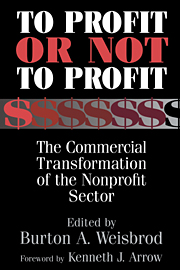Book contents
- Frontmatter
- Contents
- List of contributors
- Foreword by Kenneth J. Arrow
- Preface
- 1 The nonprofit mission and its financing: Growing links between nonprofits and the rest of the economy
- Part I Basic issues and perspective
- 2 Competition, commercialization, and the evolution of nonprofit organizational structures
- 3 Modeling the nonprofit organization as a multiproduct firm: A framework for choice
- 4 Pricing and rationing by nonprofit organizations with distributional objectives
- 5 Differential taxation of nonprofits and the commercialization of nonprofit revenues
- 6 Interdependence of commercial and donative revenues
- 7 Conversion from nonprofit to for-profit legal status: Why does it happen and should anyone care?
- Part II Industry studies
- Part III Overview, conclusions, and public-policy issues
- Appendix: IRS Forms 990 and 990-T for nonprofit organizations
- References
- Index
6 - Interdependence of commercial and donative revenues
Published online by Cambridge University Press: 30 November 2009
- Frontmatter
- Contents
- List of contributors
- Foreword by Kenneth J. Arrow
- Preface
- 1 The nonprofit mission and its financing: Growing links between nonprofits and the rest of the economy
- Part I Basic issues and perspective
- 2 Competition, commercialization, and the evolution of nonprofit organizational structures
- 3 Modeling the nonprofit organization as a multiproduct firm: A framework for choice
- 4 Pricing and rationing by nonprofit organizations with distributional objectives
- 5 Differential taxation of nonprofits and the commercialization of nonprofit revenues
- 6 Interdependence of commercial and donative revenues
- 7 Conversion from nonprofit to for-profit legal status: Why does it happen and should anyone care?
- Part II Industry studies
- Part III Overview, conclusions, and public-policy issues
- Appendix: IRS Forms 990 and 990-T for nonprofit organizations
- References
- Index
Summary
Introduction and overview
As Chapter 3 outlines, nonprofit organizations' principal sources of finance are donations and sales. That is, they can generate revenue through some form of contribution, or they may sell products and services. Proxy measures for the former are what the Internal Revenue Service terms “contributions, gifts, and grants,” and for the latter, what it terms “program service revenues” (PSRs), which include user fees and revenue from ancillary activites. Since we utilize these data extensively, it is important to be clear that PSRs encompass all sales-generating activities, whether central to the nonprofit's mission or not. Moreover, “mission relatedness” of an activity is determined by the nonprofit and also by the IRS – and these two perspectives may differ. While some activities that generate program service revenues will be treated by the IRS as taxable, because they are unrelated to organization mission, and other activities as related and, hence, not taxable, the nonprofit's own view may differ. It may judge that an activity is not central to its mission even though the IRS considers the income generated nontaxable; similarly, the nonprofit may view an activity as central to its mission even though the IRS determines it to be unrelated.
In the short run, nonprofits have additional sources of revenue – they may receive interest and dividends from investments, and can borrow and draw down assets; but in the long run their financial health depends on their ability to generate donations and to sell services profitably.
- Type
- Chapter
- Information
- To Profit or Not to ProfitThe Commercial Transformation of the Nonprofit Sector, pp. 105 - 128Publisher: Cambridge University PressPrint publication year: 1998
- 28
- Cited by



